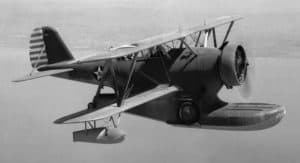On 3 September 1939, two days after the German invasion of Poland, France and Great Britain declared war against Germany. The war would expand to all of Europe. European allies, much the same as in World War I, would again look to the United States for munitions and supplies which could reach them only by ship. It was realized that the Germans would make every effort to halt such traffic and the Atlantic Ocean would become a major battleground. The mood in the United States was isolationist and the Neutrality Act of 1935, made further restrictive by amendment in 1937, forbade arms exports, either direct or by trans-shipment, to any belligerent. President Franklin D. Roosevelt issued his first proclamation of neutrality on September 5, 1939 declaring in part that any use of United States territorial waters for hostile operations would be regarded as unfriendly, offensive, and in violation of United States neutrality.
On 6 September, the Chief of Naval Operations directed the establishment of air and ship patrols to observe and report, by classified means, movements of belligerents approaching or leaving the east coast of United States or the eastern boundary of the Caribbean. Ships were to be identified by name, nationality, estimated tonnage, color, markings and were to be photographed. Course and speed was to be estimated and included in the report. By the middle of September, Atlantic coastal waters from Nova Scotia, Canada to the Lesser Antilles, were under daily surveillance by surface and air patrols.
Forces involved were primarily patrol planes from Patrol Squadron VP-51 (12 PBY-1s) which was deployed to San Juan; Patrol Squadron VP-52 (6 P2Y-2s) which deployed to the Coast Guard air station at Charleston, SC; Patrol Squadron VP-53 (12 P2Y-2s) initially based out of Norfolk and in November deployed to Key West; Patrol Squadron VP-54 (12 PBY-2s) based at Norfolk and deployed a detachment to Newport, RI; Patrol Squadron VP-33 which deployed to Guantanamo Bay, Cuba. The Navy patrol effort was expanded by Coast Guard coverage of inshore areas by aircraft based out of Miami, Charleston, Brooklyn and Salem (19 aircraft). The Coast Guard aircraft utilized were the Curtiss SOC-4, Douglas RD4, Fairchild J2K, Grumman JF-2, and the PH-2 Hall Boat.
Surface forces assigned were ships of the Atlantic Squadron, four seaplane tenders and the aircraft carrier USS RANGER with her air group. Coast Guard cutters supplemented the effort and were assigned inshore areas.
The scope of the Neutrality Patrol expanded during 1940. The war in Europe saw the apparently invincible German Forces defeat France and bring Britain to her knees by the success of the U-Boat actions in the Atlantic. The specter of a British defeat and the danger to the United States was obvious. In September of 1940 President Roosevelt announced that, by executive agreement the United States would exchange 50 World War I destroyers and 10 Coast Guard cutters for 99 year leases on British sea and air bases in the Western Hemisphere. The “Destroyers for Bases Deal” marked the functional death of U.S. neutrality and the beginning of a period of “non-belligerency.” Two of the sites, Argentia, Newfoundland and Bermuda became key elements in the Battle of the Atlantic.
Patrol Squadrons VP-55 and VP-56 were commissioned and both equipped with PBM-1s. VP -54 deployed to Bermuda and VP-52, after acquiring PBY aircraft and finding the Coast Guard air station at Charleston no longer large enough to support a PBY operation, deployed to San Juan and then to Argentia, Newfoundland. The Coast Guard acquired Grumman JRF amphibians in 1940 and the Grumman J4F amphibian came on board in 1941. These aircraft replaced the RD4s and the JK-1s. On April 8, 1941 VP-51 moved to NAS New York (Floyd Bennett Field) and together with VP-52 based at Argentia, patrol activity was expanded to include convoy escort and ASW search in the northern offshore shipping lanes.
As the countdown toward WW II continued during the final months of 1941, the Neutrality Patrol operations moved ever farther from “neutrality” toward active support of the Allies. Convoy escort and ASW patrol planes began carrying general-purpose and depth bombs during the summer months. Orders for attacks on hostile forces threatening U.S. and non-Axis foreign flag shipping were in force and were amplified and extended by Navy Argentia Air Detachment Op Orders in September and October. Based on Commander in Chief, Atlantic Fleet (CINCLANTFLT) orders, these directives were explicit regarding the protection of shipping. With the torpedoing of the USS Kearny (DD-432) and the loss of the of the USS Reuben James (DD-245) Congress took action to relax the restrictions of the Neutrality Act by allowing U.S. ships to escort convoys into combat zones and U.S. merchant ships to be armed.
Just five weeks after these final events in the history of the Neutrality Patrol, the attack on Pearl Harbor plunged the United States into WW II.







